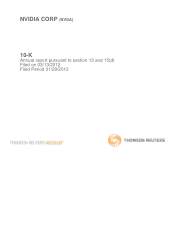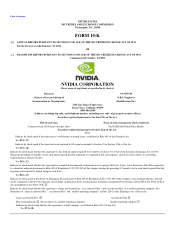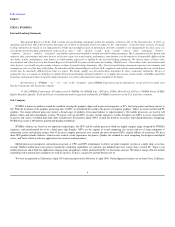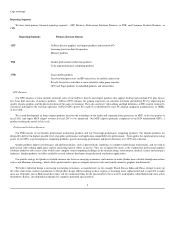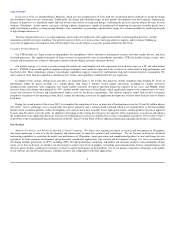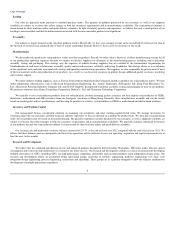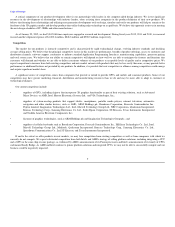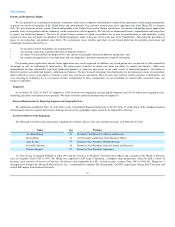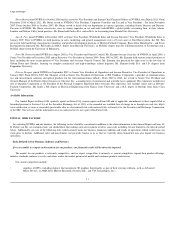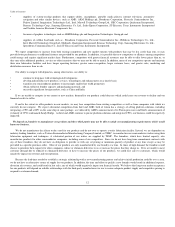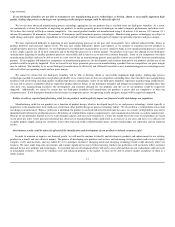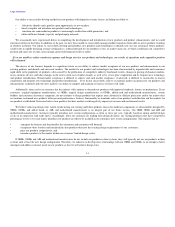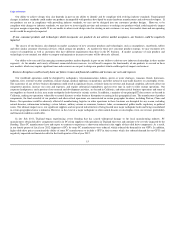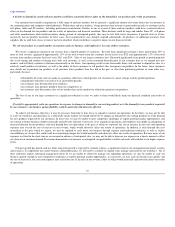NVIDIA 2012 Annual Report Download - page 7
Download and view the complete annual report
Please find page 7 of the 2012 NVIDIA annual report below. You can navigate through the pages in the report by either clicking on the pages listed below, or by using the keyword search tool below to find specific information within the annual report.
Table of Contents
In fiscal year 2012, we launched Project Maximus, which uses the compute power of Tesla with the visualization power of Quadro to merge the design
and simulation stages into one workstation. Traditionally, the design and simulation stages of new product development have been separate, requiring the
designer to hand over to a simulation expert and wait for the results before revising their design. Combining the processes greatly reduces the time for each
iteration. “Simulation”, in this context, can mean verifying a plastic component is capable of manufacture by modeling the injection of molten plastic into a
mold, determining a product is strong enough through a stress simulation, or generating a photorealistic image of a consumer product by simulating the path
of light through and across it.
Tesla has had particular success in supercomputing centers and in oil exploration; other applications include accelerating drug discovery, weather
simulations and derivative price modeling. Our growth strategy for Tesla is to focus on these and some other key markets, and to continue building an
ecosystem of applications, development tools and developers who can develop for a massively parallel architecture like Tesla.
Consumer Products Business
Our CPB includes our Tegra system-on-chip products for smartphones, tablets, automotive infotainment systems, and other similar devices, and Icera
baseband processors. The significant majority of Tegra revenues are generated by sales in smart phones and tablets. CPB also includes license, royalty, other
revenue and associated costs related to video game consoles and other digital consumer electronics devices.
Our mobile strategy is to create a system-on-chip that enables the entertainment and web experiences that end users enjoy on a PC and other mobile
devices. NVIDIA Tegra mobile products implement design techniques, both inside the chips and at the system level, which result in high performance and
long battery life. These technologies enhance visual display capabilities, improve connectivity and minimize chip and system-level power consumption. We
aim to innovate faster than the competition, introducing new features and capabilities to differentiate the user experience.
In support of this strategy, during fiscal year 2012, we launched Tegra 3, the world's first quad-core mobile computing chip, bringing PC levels of
performance within the power envelope of a cellular phone chip. Tegra 3 includes several unique innovations, including its variable symmetric
multiprocessing architecture with companion core which enables extremely low-power operation during the majority of use cases, and PRISM, which
increases battery life during video playback by 40%. Another notable innovation is DirectTouch, which significantly improves the responsiveness of touch-
screen user interfaces on devices and simultaneously reduces costs for the device manufacturer. Our software expertise makes both of these inventions
completely transparent to the operating system; that is, neither the operating system nor the application developer has to know about them for users to benefit
from them.
During the second quarter of fiscal year 2012, we completed the acquisition of Icera, an innovator of baseband processors for 3G and 4G cellular phones
and tablets. Icera's technology uses a custom-built, low-power processor and a software-based baseband which assist manufacturers to develop multiple
products from a common platform, reduce development costs and accelerate time to market. Icera's high-speed wireless modem products have been approved
by more than 50 carriers across the globe. In addition to leveraging on the existing Icera business, the objective of the acquisition is to accelerate and enhance
the combination of our application processor with Icera's baseband processor for use in mobile devices such as smartphone and tablets. Please refer to Note 7
of the Notes to the Consolidated Financial Statements in Part IV, Item 15 of this Form 10-K for additional information regarding this business combination.
Our Strategy
Maintain Technology and Product Leadership in Visual Computing. We believe that ongoing investment in research and development in 3D graphics
and image processing is critical to the development and enhancement of innovative products and technologies. We are focused on using our advanced
engineering capabilities to accelerate the quality and performance of 3D graphics, image processing and computational graphics to raise and change the user
experience for both consumer entertainment and professional visualization applications. Our research and development strategy is to focus on concurrently
developing multiple generations of GPUs, including GPUs for high-performance computing, and mobile and consumer products using independent design
teams. As we have in the past, we intend to use this strategy to achieve new levels of graphics, networking and communications features and performance and
ultra-low power designs, enabling our customers to achieve superior performance in their products. One of our primary competitive advantages is the quality
of our software, measured by performance, reliability, features and compatibility with other applications.
6

